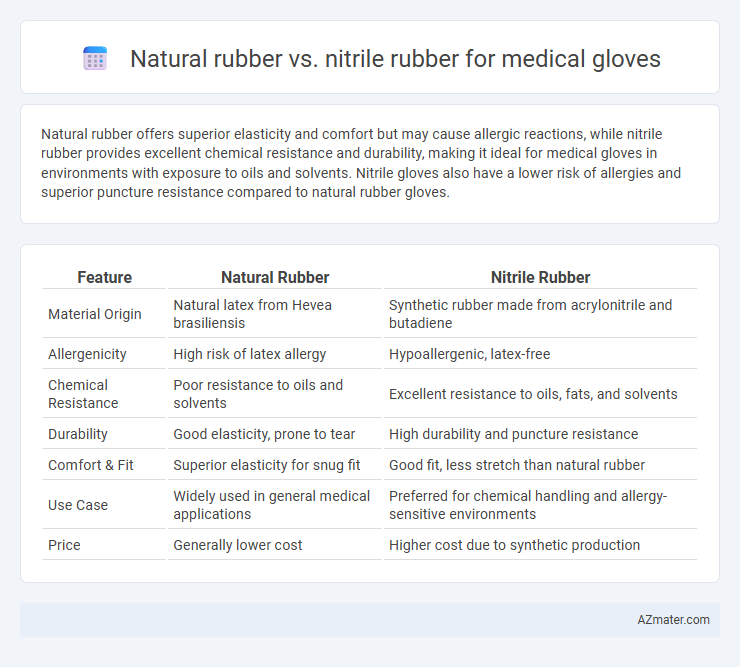Natural rubber offers superior elasticity and comfort but may cause allergic reactions, while nitrile rubber provides excellent chemical resistance and durability, making it ideal for medical gloves in environments with exposure to oils and solvents. Nitrile gloves also have a lower risk of allergies and superior puncture resistance compared to natural rubber gloves.
Table of Comparison
| Feature | Natural Rubber | Nitrile Rubber |
|---|---|---|
| Material Origin | Natural latex from Hevea brasiliensis | Synthetic rubber made from acrylonitrile and butadiene |
| Allergenicity | High risk of latex allergy | Hypoallergenic, latex-free |
| Chemical Resistance | Poor resistance to oils and solvents | Excellent resistance to oils, fats, and solvents |
| Durability | Good elasticity, prone to tear | High durability and puncture resistance |
| Comfort & Fit | Superior elasticity for snug fit | Good fit, less stretch than natural rubber |
| Use Case | Widely used in general medical applications | Preferred for chemical handling and allergy-sensitive environments |
| Price | Generally lower cost | Higher cost due to synthetic production |
Introduction to Medical Glove Materials
Medical gloves are primarily made from natural rubber latex and nitrile rubber, each offering distinct advantages for healthcare applications. Natural rubber provides excellent elasticity, comfort, and tactile sensitivity, making it suitable for tasks requiring precision. Nitrile rubber, a synthetic alternative, offers superior chemical resistance, puncture protection, and hypoallergenic properties, ideal for environments with potential exposure to oils, solvents, and allergens.
What is Natural Rubber?
Natural rubber, derived from the latex sap of Hevea brasiliensis trees, is renowned for its excellent elasticity, high tensile strength, and superior comfort in medical gloves. It offers outstanding barrier protection against biological hazards, making it a preferred choice for surgical and examination gloves. Despite its advantages, natural rubber can cause allergic reactions in some individuals due to its protein content, prompting consideration of alternatives like nitrile rubber.
What is Nitrile Rubber?
Nitrile rubber is a synthetic elastomer derived from acrylonitrile and butadiene, widely used in medical gloves for its superior chemical resistance and puncture durability compared to natural rubber. It offers excellent protection against oils, solvents, and bloodborne pathogens, making it ideal for healthcare settings. Unlike natural rubber, nitrile rubber gloves are hypoallergenic, reducing the risk of latex allergies among medical professionals and patients.
Key Differences in Composition
Natural rubber gloves are primarily made from latex, a polymer of isoprene derived from the sap of rubber trees, offering excellent elasticity and comfort. Nitrile rubber gloves consist of synthetic copolymers of acrylonitrile and butadiene, providing superior chemical resistance and durability. The key compositional difference lies in natural rubber's organic isoprene base versus nitrile's synthetic acrylonitrile-butadiene matrix, impacting allergenicity and performance in medical applications.
Glove Performance: Durability and Strength
Natural rubber gloves exhibit superior elasticity and tensile strength, providing excellent durability and resistance to tearing under stress, making them ideal for tasks requiring high flexibility. Nitrile rubber gloves offer enhanced puncture resistance and chemical durability, maintaining strength in harsh environments and reducing the risk of glove failure during medical procedures. Both materials ensure protective barrier integrity, but nitrile excels in environments involving oils, solvents, and extended wear, while natural rubber prioritizes comfort and fit.
Allergen Risks: Latex vs. Nitrile
Natural rubber gloves contain latex proteins that can trigger Type I hypersensitivity reactions, posing significant allergen risks for sensitive individuals in medical settings. Nitrile gloves, synthesized from synthetic rubber copolymers, are free of natural latex proteins, making them hypoallergenic and safer for patients and healthcare workers with latex allergies. Choosing nitrile over natural rubber gloves reduces potential allergic contact dermatitis and anaphylactic reactions, optimizing safety in clinical environments.
Barrier Protection and Puncture Resistance
Natural rubber gloves provide superior elasticity and tactile sensitivity, enhancing barrier protection against viruses and bacteria due to their excellent fit and strength. Nitrile rubber gloves offer enhanced puncture resistance and chemical impermeability, making them ideal for handling hazardous substances and sharp instruments in medical environments. While natural rubber excels in comfort and biodegradability, nitrile rubber's synthetic composition ensures greater durability and reduced allergy risk for extended protective performance.
Comfort, Fit, and Tactile Sensitivity
Natural rubber gloves provide superior elasticity and flexibility, offering exceptional comfort and a snug fit that enhances tactile sensitivity, making them ideal for delicate medical procedures. Nitrile gloves, while slightly less elastic, deliver excellent chemical resistance and durability without sacrificing fit, but may feel less flexible compared to natural rubber. The choice between natural and nitrile rubber for medical gloves typically balances tactile precision and allergy concerns, with natural rubber favored for comfort and sensitivity and nitrile preferred for protection and durability.
Environmental Impact and Sustainability
Natural rubber gloves, derived from renewable latex sources, offer superior biodegradability, reducing long-term environmental waste compared to synthetic alternatives. Nitrile gloves, synthesized from petroleum-based chemicals, pose greater environmental challenges due to their non-biodegradable nature and reliance on fossil fuels. Sustainable glove manufacturing increasingly favors natural rubber to minimize ecological footprints and promote circular economy principles in healthcare supplies.
Choosing the Right Glove: Applications and Recommendations
Natural rubber gloves offer superior elasticity and tactile sensitivity, making them ideal for surgical and examination procedures requiring dexterity and touch precision. Nitrile gloves provide excellent chemical resistance and reduced allergenic potential, suitable for handling hazardous substances and prolonged wear in clinical settings. Selecting the right glove depends on the specific medical application, balancing the need for protection, comfort, and potential latex allergies.

Infographic: Natural rubber vs Nitrile rubber for Medical glove
 azmater.com
azmater.com